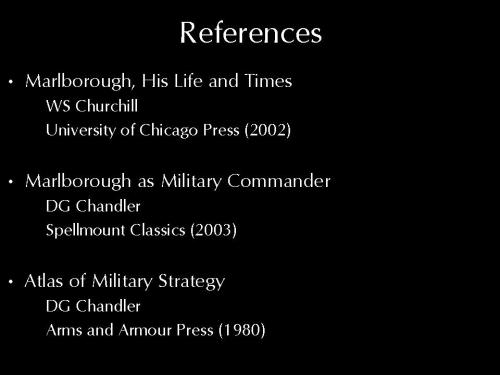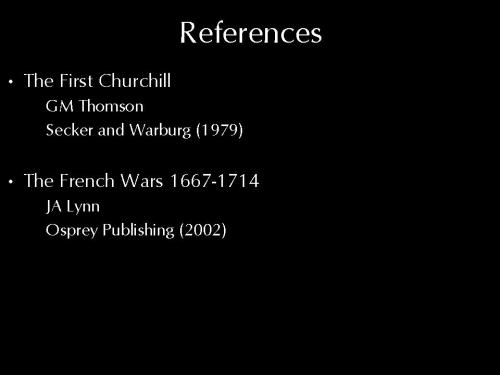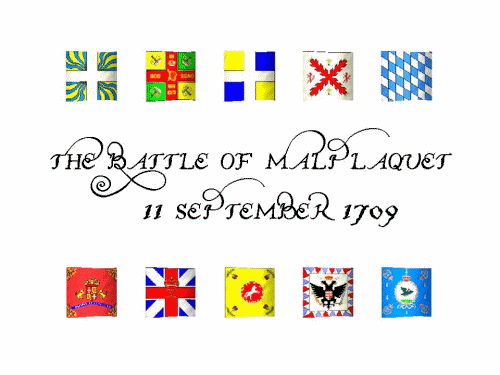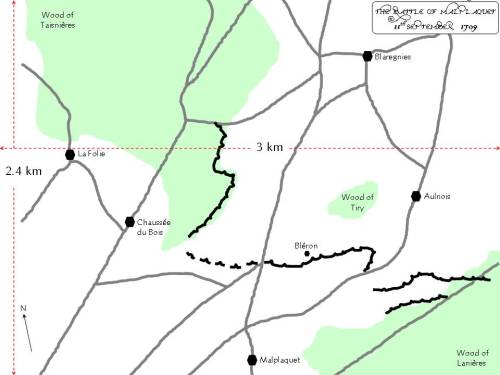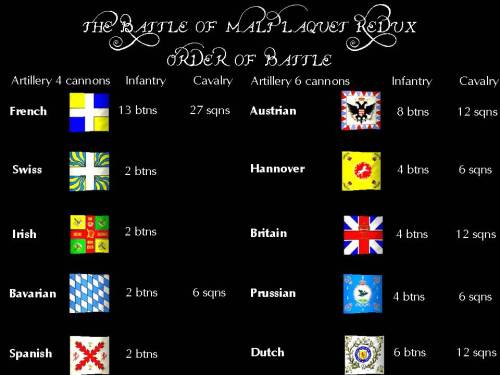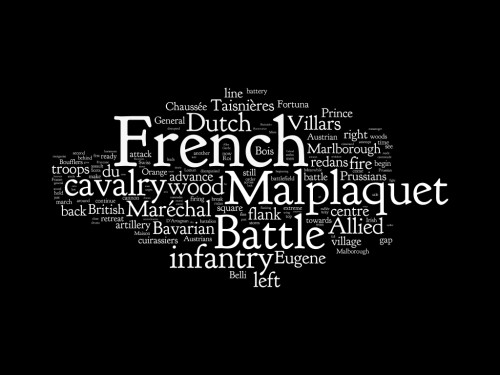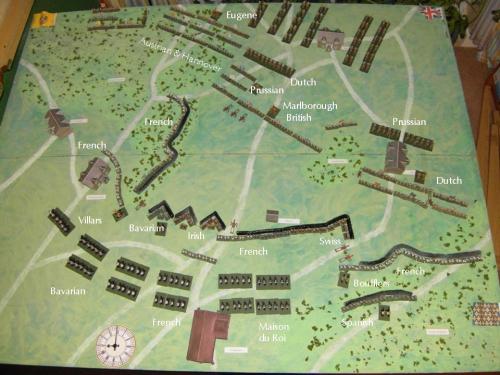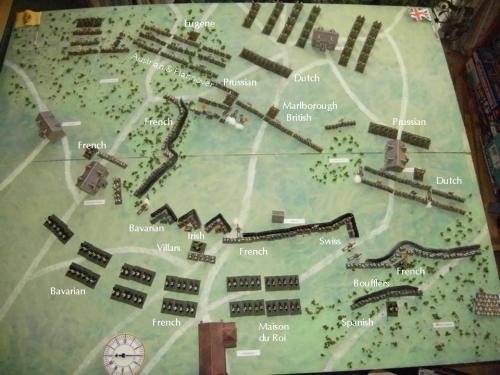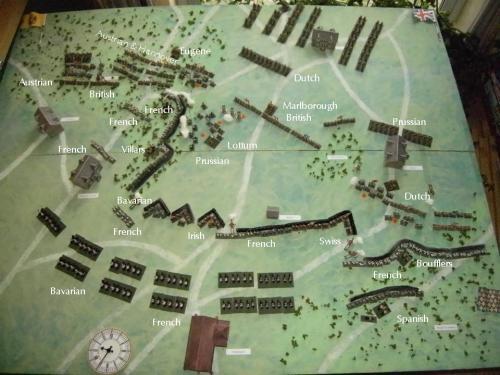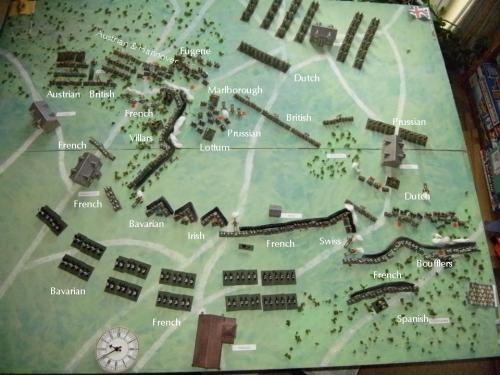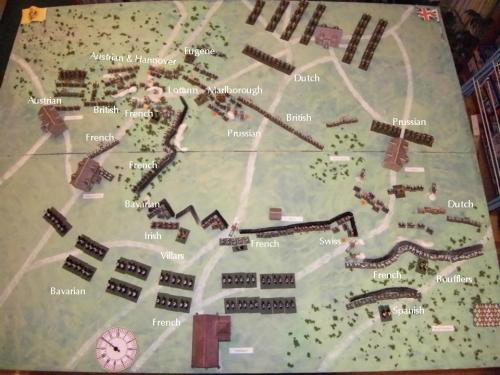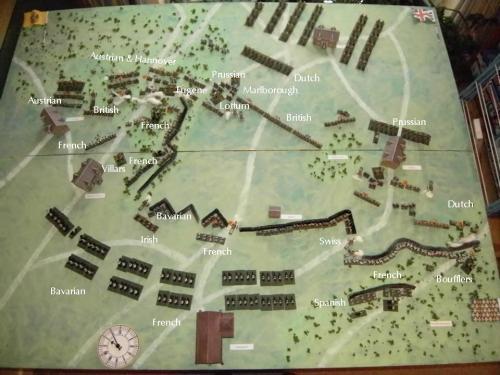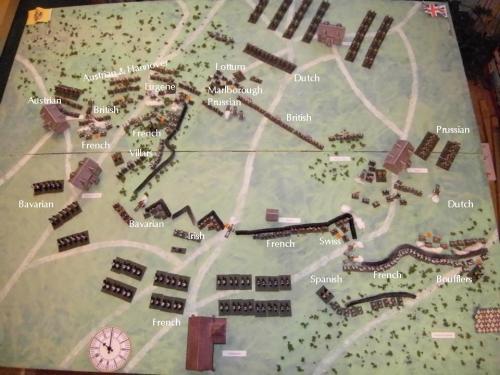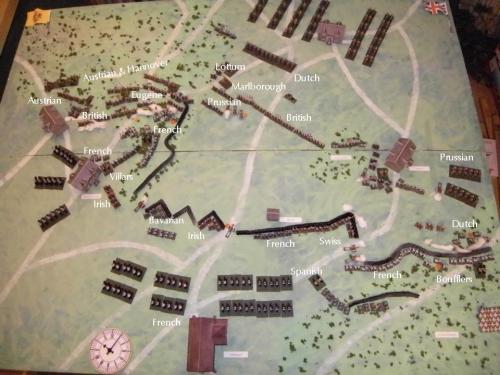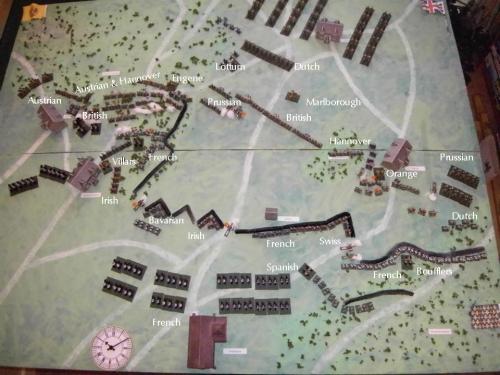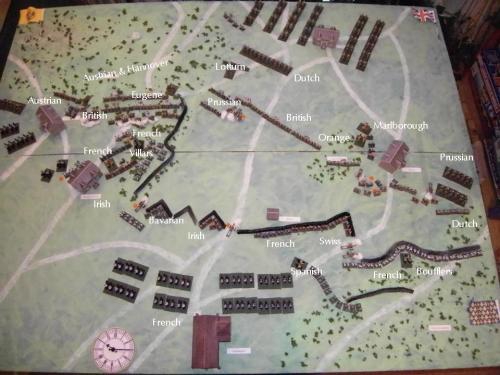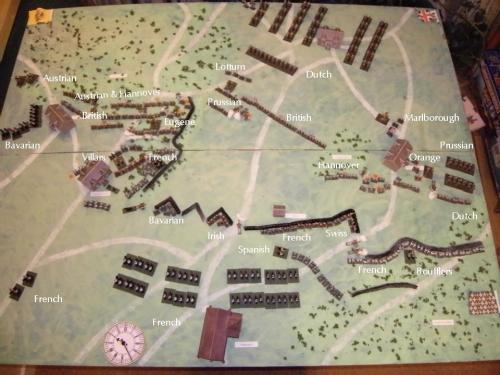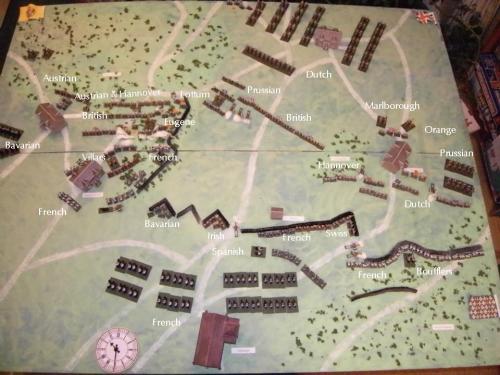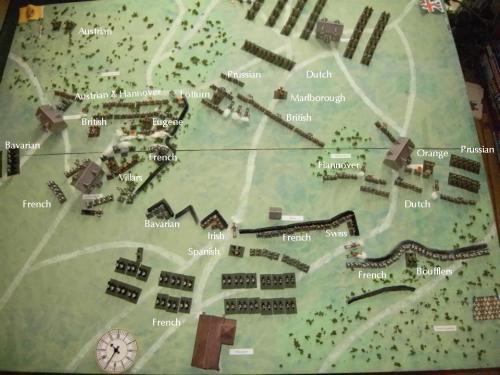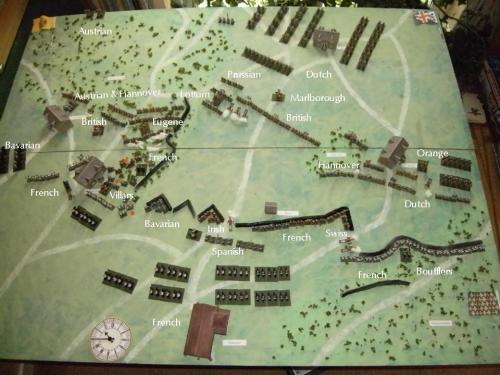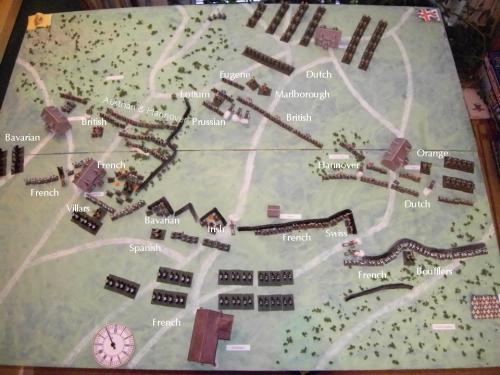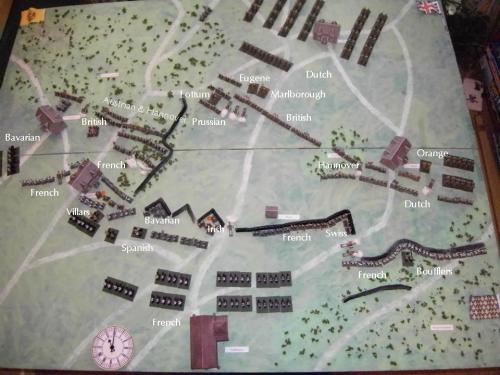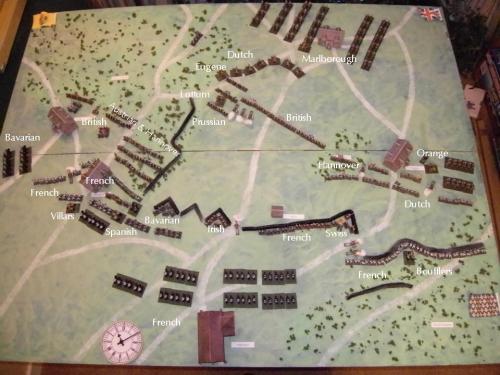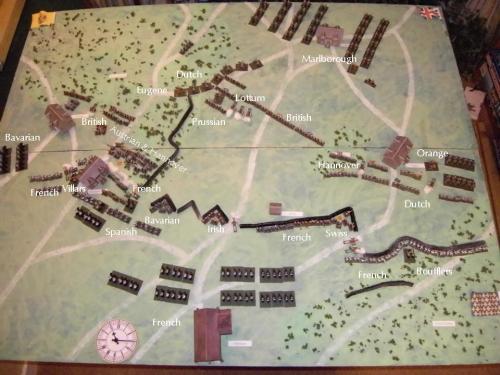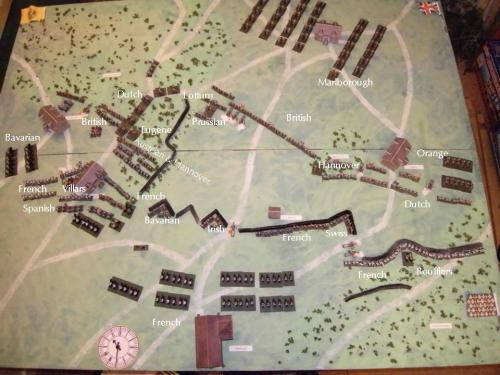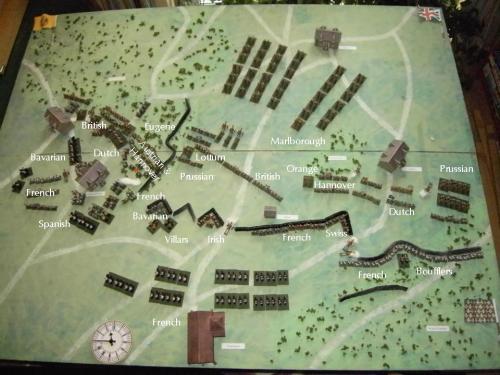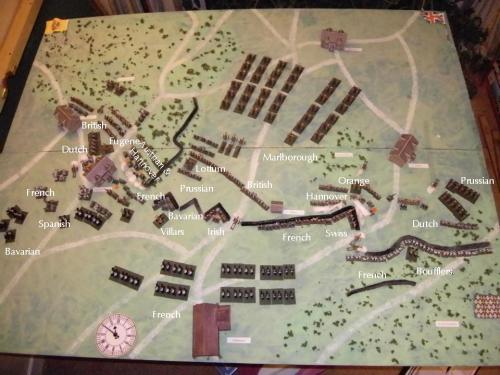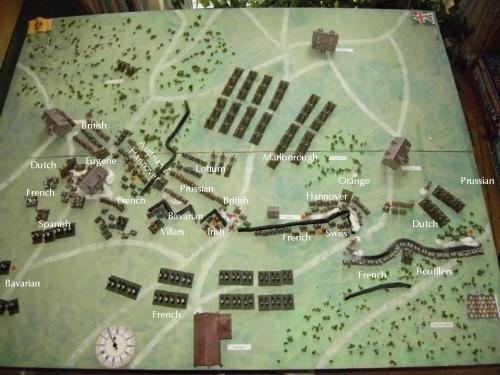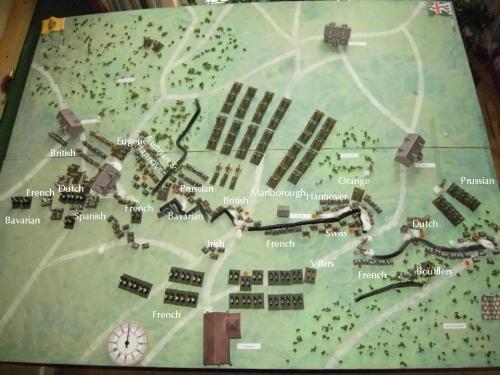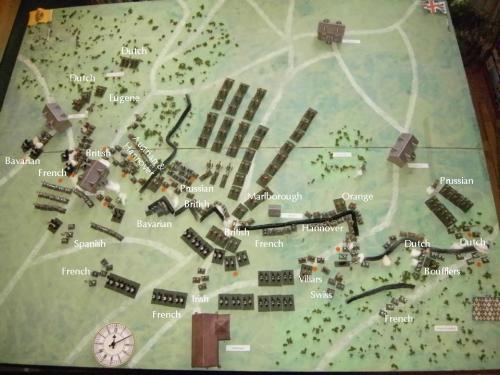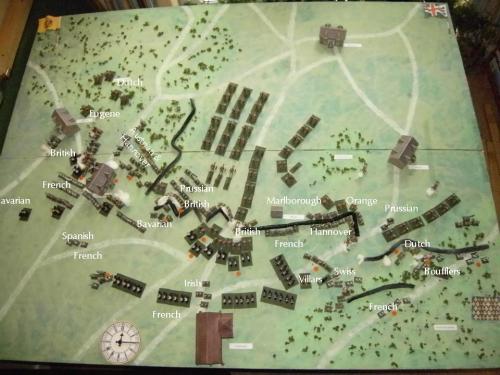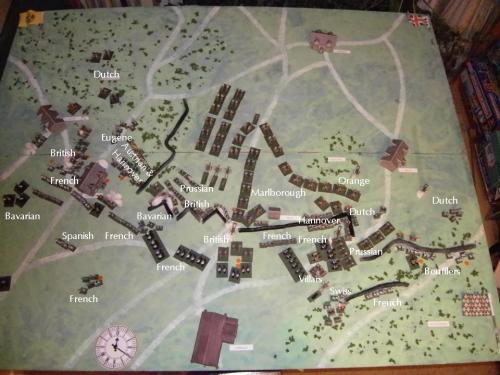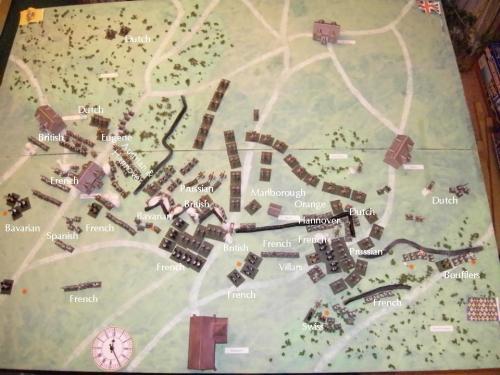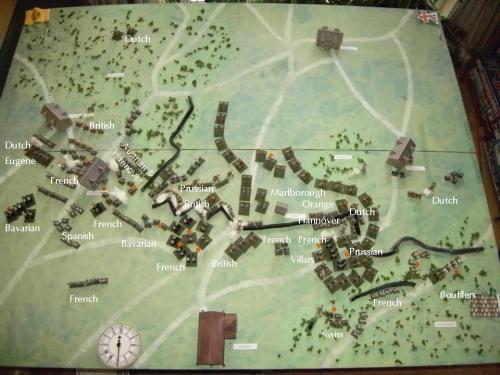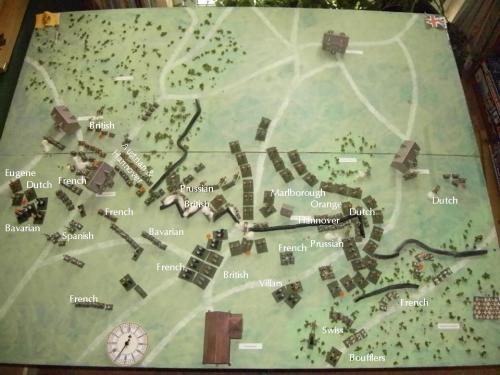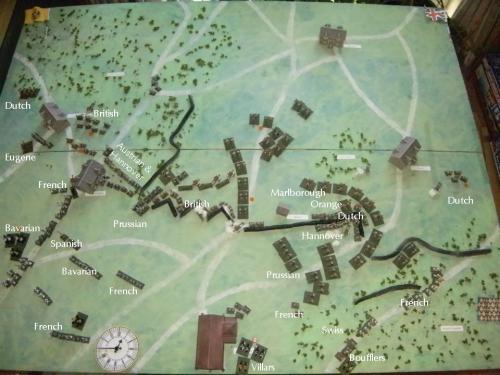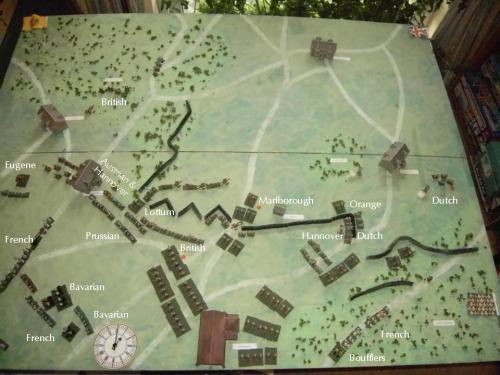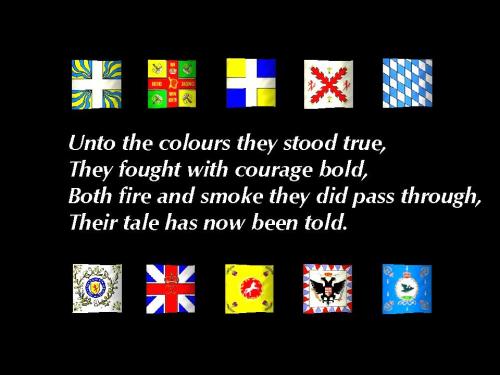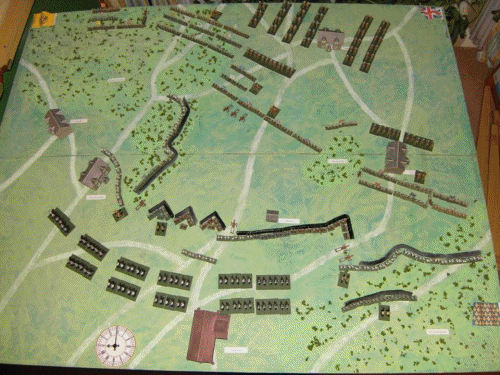The battle of Malplaquet was the bloodiest encounter in the 18th century, and was the climax of the campaign of 1709 during the war of the Spanish Succession.
Hopes for peace were high at the start of the year, after the successful campaign by the Allied forces, led by the Duke of Malborough and Prince Eugene in 1708. France was close to breaking point.
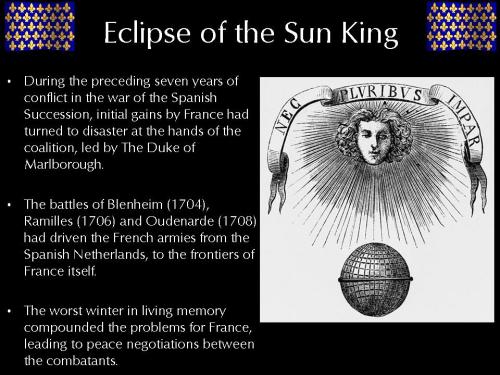
Peace negotiations were established, but the Allies demanded too much in requiring Louis XIV to remove his grandson from the throne of Spain (the initial cause of the war), in favour of the Holy Roman Emperor, Charles VI.
The French would not comply with this demand, ensuring that the war would be fought to a bitter conclusion, much to Marlborough and the Allies regret.

Louis XIV appointed Marshal Villars to lead the battered French Army and defend the borders of France. He quickly improved them in terms of morale and matériel.
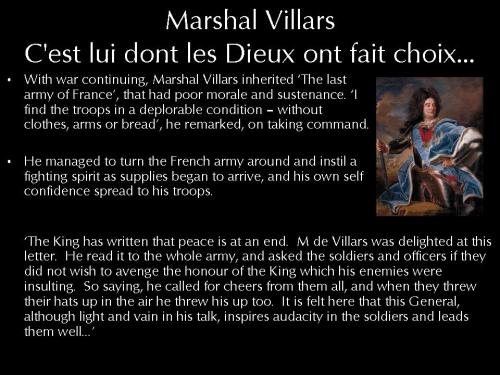
The campaign of 1709 opened with a flanking move to the east, and the besiegement of Tournai.

Eventually Tournai fell to the allies.
This led the way clear for the Allies to continue their eastwards flanking move, hoping to bypass the defensive lines built by the French. In early Septemeber, the Allies moved on Mons. Villars recognised a battle was close at hand. He received a letter from Louis XIV:-
‘should Mons follow on the same fate of Tournai, our case is undone; you are by every means in your power to relieve the garrison; the cost is not to be considered, the salvation of France is at stake.’
Marshal Boufflers joined the French army, ‘with his cuirass and weapons’, to serve under Marshal Villars.
On the eve of the battle, the Allies stood their force in two bodies on the plain of Mons before the woods, hoping to tempt Marshal Villars and his army through the Aulnois gap onto the plain of Mons beyond. Instead Villars moved his army into the Aulnois gap and began constructing redans in the woods on each flank, which were considered by the conventions of the day to secure them. In the gap itself further redans were built, creating a strong defensive position.
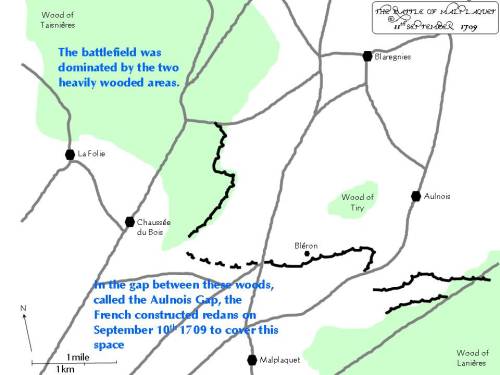
Villars and Boufflers had some 80,000 men and 80 cannon.
Marlborough and Eugene had some 110,000 men and 120 cannon, and thus had an overall advantage of ~4:3 in men.
The Allied plan of attack for September 11th followed the basic pattern of the battle of Blenheim.

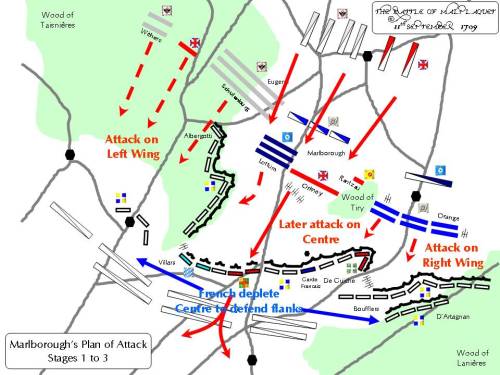
The Greeks believed in “Ethos Anthropos Daimon”; a man’s character is his fate. The brilliant victories by the Duke of Marlborough at the Battles of Blenheim and Ramilles had used central attacks. Villars would make his centre as defensible as possible with redans, stretching into the woods either side of the Aulnois gap, and let Marlborough’s men bleed to death in the expected assaults.
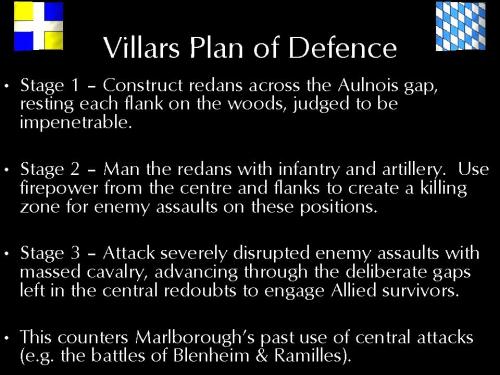
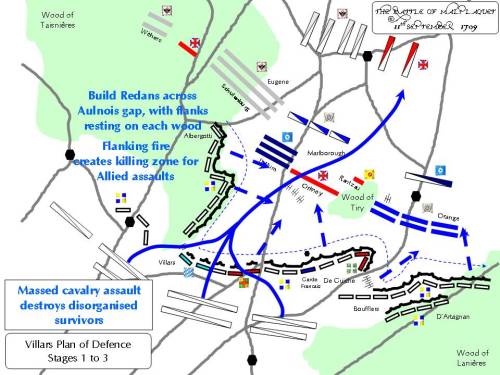
The French counterplan relied heavily on the assumption that the wooded flanks were secure from Allied incursions, as normally assumed during this period. However, fog lifted slowly from the battlefield on the morning of September 11th, allowing the Allies to deploy large number of troop in the wood of Taisnières unnoticed.
For the main attack on the French left wing, three lines of troops were used; about 80 battalions of Imperialists in all, under Prince Eugene.
For the secondary attack on the French right wing, two lines of troops were used; about 30 battalions of Dutch, under the Prince of Orange.
For the final central attack, only one line of troops were used; about 19 battalions of mostly British, together with the major part of the artillery and the cavalry reserve of about 200 squadrons of cavalry (some 30,000 horsemen) under the Duke of Marlborough.
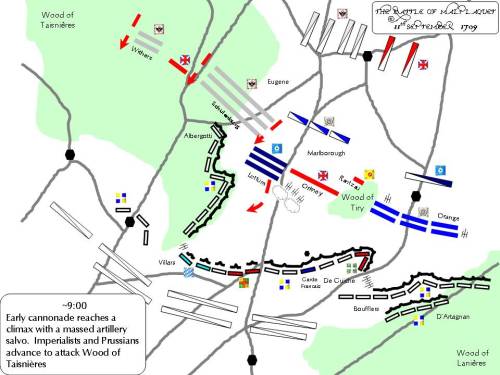
The Imperialist and Prussian troops began their assault on the wood of Taisnières, but were stopped by unexpectedly fierce resistance from the French infantry.
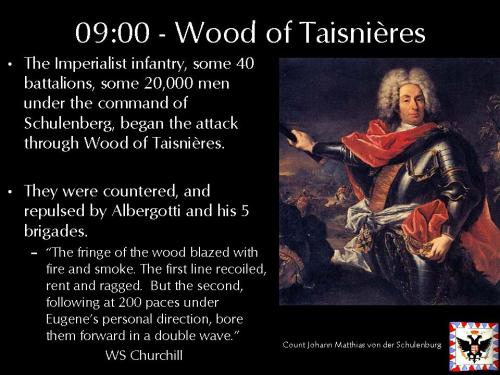
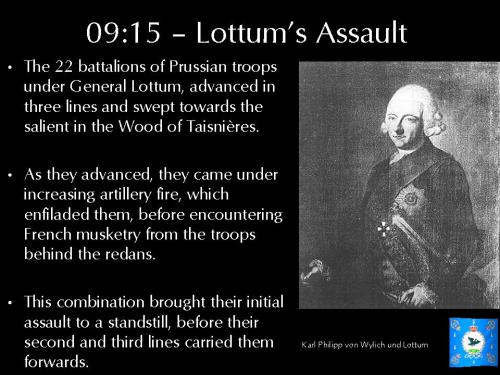
The account of La Colonie, the Bavarian army ‘Old Campaigner’ describes the advance of the Prussians under fire towards the wood of Taisnières.
“As soon as this dense column appeared in the avenue, fourteen guns were promptly brought up in front of our brigade almost in line with the regiment of Garde Franchise. The fire of this battery was terrific, and hardly a shot missed its mark. I could not help noticing the officer in command, who although he seemed elderly was nevertheless so active that in giving his orders there was no cessation of action anywhere, the cannon shot continued to pour forth without a break, plunged into the enemy’s infantry and carried off whole ranks at a time, but a gap was no sooner created than it was immediately filled again, and they even continued their advance upon us without giving us any idea of the actual point determined on for their attack. At last the column, leaving the great battery on its left, changed its direction a quarter right and threw itself precipitately into the wood on our left, making an assault upon that portion which had been breached.”
The day was turning bloody indeed, and it was clear that the French would fight to hold every position.
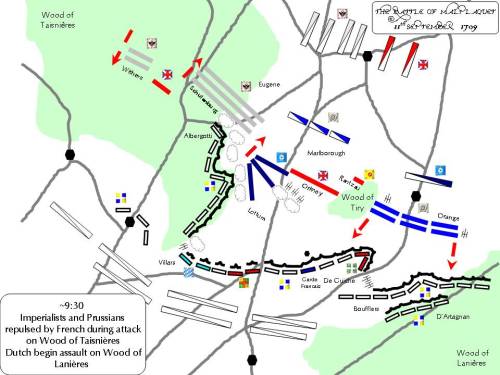
The Prince of Orange led 30 Dutch battalions in an assault of the French redans before the wood of Lanières.
Again, the French mounted a stiff resistance, firing at close range, and opening up enfilading grapeshot fire with cannon, concealed in low ground. Terrible casualties were inflicted. The Dutch reached the line of redans, only to be met with further musketry from the French infantry, forcing the Dutch to retire in good order.
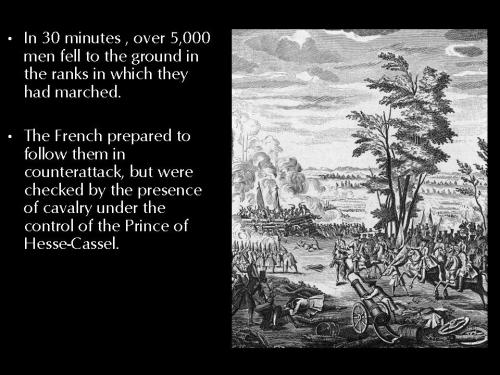
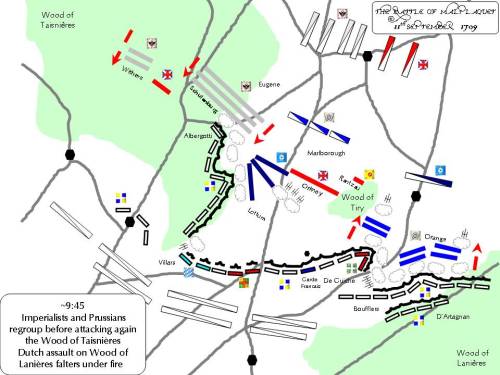
Both assaults on the prepared positions had failed. The Allies regrouped and tried again.
The Prince of Orange led the survivors in a new assault on the French. The Dutch troops followed, with the officers falling alongside their men, including Generals Spaar & Week.
Once again, French enfilading grapeshot and musketry did their terrible work, before the Dutch reached the redans, only to be thrown back by a spirited counterattack. The Dutch retired in disorder, and might have been chased from the field but for cavalry assistance.
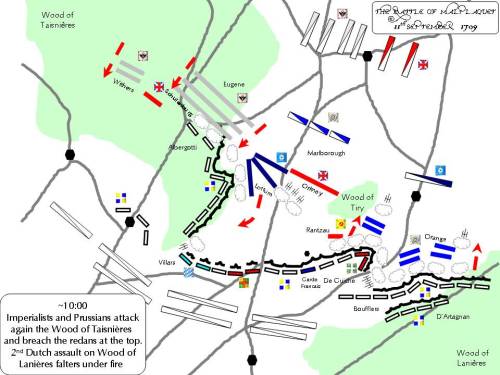
Schulenburg led the survivors of the Imperialist first attack to a new assault of the French in the wood of Taisnières, this time breaking through the north face.
Lottum’s Prussians fared little better in their second assault, being brought to a halt, ‘torn and exhausted’. An English brigade under Argyll went in support of this assault.
Inside the wood of Taisnières, over seven thousand men were killed and wounded. The Allied infantry pursued the remaining four or five thousand French survivors. Little quarter was given on either side.
‘They hewed in pieces all they found before them, … even the dead when their fury found no more living to devour.’
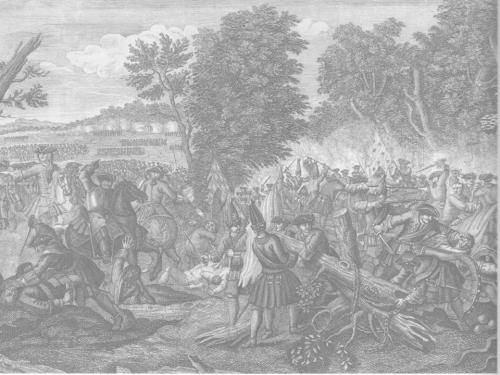
By 10:30 Marlborough was aware that the first Dutch assault failed and rode over to see the troops, when he was intercepted by Goslinga, the Dutch deputy in the field.
Goslinga told the tale of the double repulse and together both men, joined by Prince Eugene, rode over to see the Prince of Orange ready to lead his shattered remnants in a third assault; this the Duke forbade.
‘Our left was the Dutch troops only, who beheaved themselves extremely well, but could not force the enemy retrenchment, so that their effort has suffered more than any other nation’
Marlborough, after the battle.
By 11:30, Villars sensed his left flank was slowly crumbling under the weight of numbers of troops employed by the Allies.
He did the only thing possible by withdrawing troops from his centre, exactly as Marlborough had intended, taking the Irish, French and Bavarians from the redans and sending them into the Wood of Taisnières as reinforcements.
‘By the time the Irish Brigade had got well into the wood it was considered to be hardly sufficient as a reinforcement by itself, and an order came for us to follow it, although there was no one else left to fill our place which would be left open to the enemy. They would not fail to seize it, as they could then attack the Maison du Roi with a great chance of success by simply lining the outside of our entrenchments, a manoeuvre quite possible for them to carry out. When the first order was brought to the brigade-major, who reported it to me, I refused to obey it, and pointed out the absolute necessity that existed for our maintaining the position we were holding ; but a lieutenant-general then arrived on the scene, and ordered us a second time to march off, so sharply that all our remonstrances were useless. We abandoned our post and marched into the wood to join in the fusilade with the others.’ Jean de la Colonie
Despite his defensive traps, Villars was being forced by relentless pressure to comply with Marlborough and Eugene’s plan.
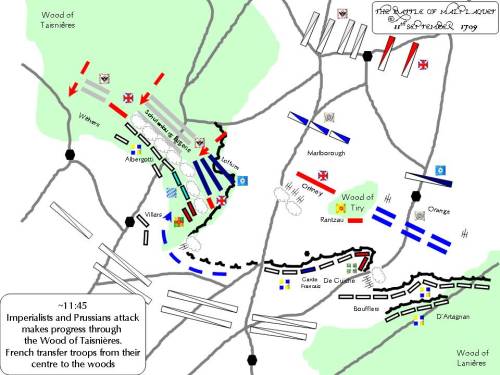
Command in the front line on the battlefield in the age of muskets meant taking your chances in combat, along with everyone else. Prince Eugene was wounded, but not seriously.
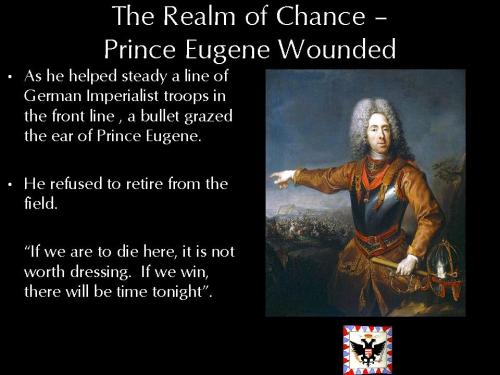
Men from one nation fought on each side during this battle. Two Swiss (Bernese) regiments had a bayonet fight, one in the French and one in the Dutch service respectively. In the wood of Taisnières, the Royal Irish met and fought the French Royal Irish Regiment, the ‘Wild Geese’. This account survives, and illustrates the tactical advance used by the British and Dutch infantry in platoon firing, rather than firing by ranks, as used by the French.
‘…When the army advanced to attack the enemy, we also advanced into that part of the wood, which was in our front. We continued marching slowly on, til we came to an open in the wood. It was a small plain, on the opposite side of which we perceived a battalion of the enemy drawn up, a skirt of the wood being in the rear of them. Upon this Colonel Keane, who was then head of the Regiment, having drawn us up, and formed our platoons, advanced gently towards them, with the six platoons of out first firing made ready. When we had advanced within a hundred paces of them, they gave us the fire of one of their ranks; whereupon we halted, and returned them the fire of our six platoons at once; and immediately made ready the six platoons of our second fire, and advanced upon them again. They then gave us the fire of another rank, and we returned them a second fire, which made them shrink; however, they gave us the fire of a third rank after a scattering manner, and then retired into the wood in great disorder: on the which we send our third fire after them, and saw them no more. We advanced cautiously up to the ground which they had quitted, and found several of them killed and wounded; among them Lieutenant O’Sullivan, who told us the battalion we had engaged was the Royal Regiment of Ireland. Here, therefore, there was a fair trial of skill between the two Royal Regiments of Ireland, one in the British, the other in the French service; for we met upon equal terms, and there was none else to interpose. We had but four men killed and six wounded: and found near forty of them on the spot killed and wounded.’ Captain Parker
By midday, the French had been driven from the wood of Taisnières, and began reorganising between the villages of La Folie and Chaussée du Bois for a counterattack.
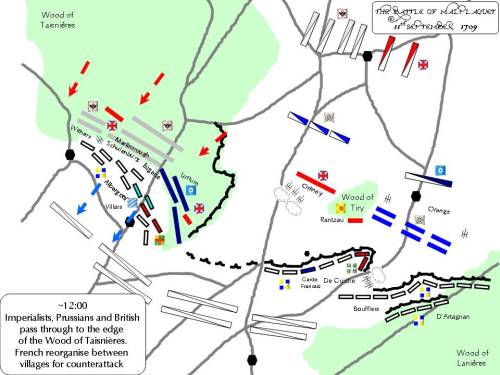
General Schulenburg prompted Marlborough to notice the empty French centre and to occupy it.
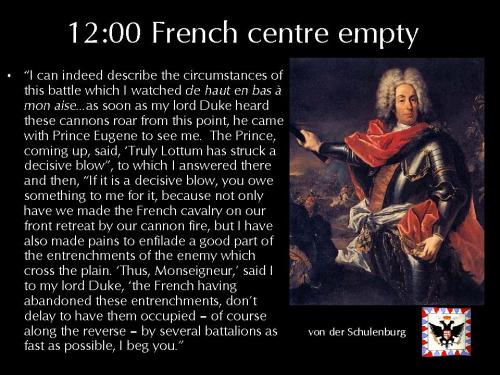
The path to victory for the Allies lay open if they could seize their opportunity quickly.
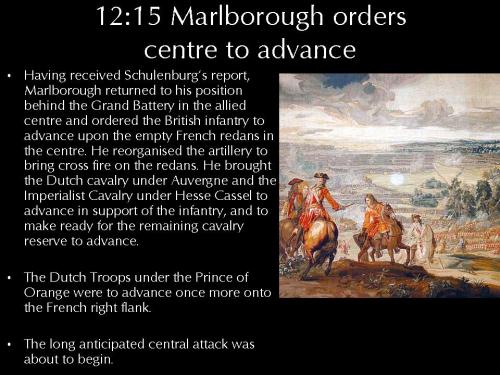
The Allied centre advanced to attack the empty French centre.
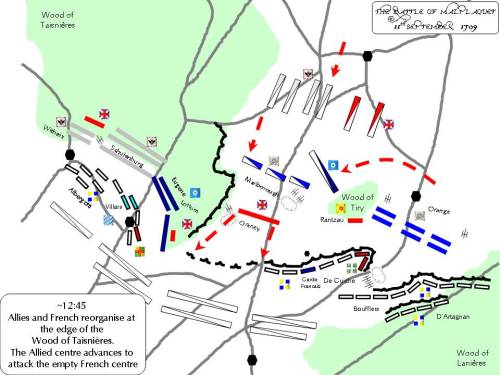
‘It was the most deliberate, solemn, and well-ordered battle I ever saw – a noble and fine disposition, and as nobly executed. Every man was at his post; and I never saw troops engage with more cheerfulness, boldness and resolution. In all the soldiers faces appeared a brisk and lively gaiety which presaged victory. The Lord of Hosts went forth at our head as Captain of our host, and the army followed with a daring cheerful boldness, for we never doubted but we would beat them. Providence ordered it so, that our regiment was no farther engaged than by being cannonaded, which was, indeed, the most severe that ever our regiment suffered, and by which we had considerable loss. But the soldiers endured it without shrinking, very patiently, and with great courage. For my own part I was nobly and richly supplied, as I have always been on these occasions, with liberal supplies of grace and strength, as the exigencies of the day called for. I never has a more pleasant day in my life. I was kept in perfect peace; my mind stayed, trusting in God.’ Major Blackadder
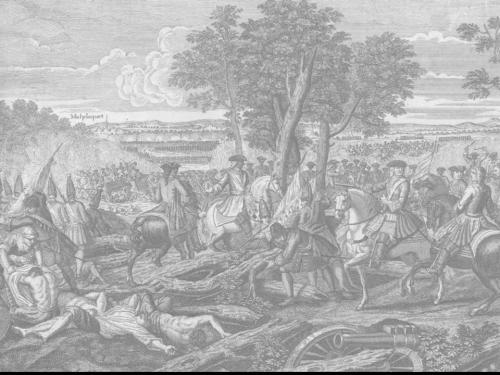
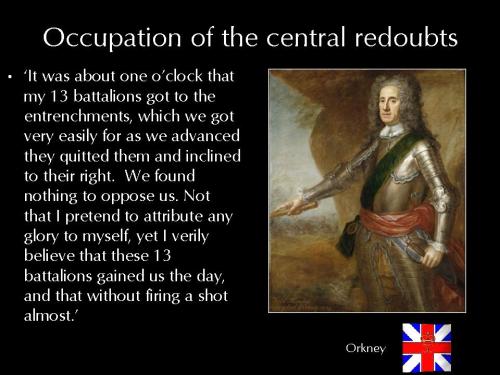
The Dutch squadrons of Auvergne passed through the gaps in the redans, followed by the British cavalry under General Wood, and the rest of the Prussian, Hannoverian and Imperialist cavalry, some 30,000 horsemen in total, to begin the biggest cavalry battle in the eighteenth century.
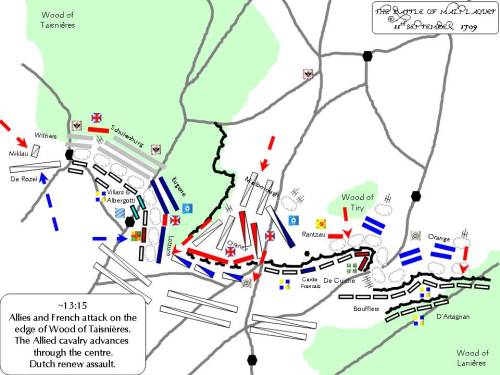
Exchange of fire was a trial of endurance and nerve, and well as chance, as Corporal Bishop’s account makes clear.
‘They returned our volley with great success. I may say it, for my right and left hand men were shot dead, and in falling had almost thrown me down, for I could scare prevent my falling among the dead men. Then I said to the second rank: ‘Come my boys, make good the front.’ With that they drew up. Then I said: ‘Never fear, we shall have better luck the next throw.’ But I just saved my word, for my right hand man was shot through the head, and the man that followed me was shot through the groin, and I escaped all, though nothing but the Providence of God could protect me. Then our rear man was called up to be a front; but he poor man was struck with a panic, fearing that he should share the same fate as the others did. He endeavoured to half cover himself behind me, but I put out my hand behind me and pulled him up, and told him, that I could no ways screen him, for he was sensible a man behind him was shot. By strong persuasion I prevailed upon him, so that he was not in the least bit daunted, but stood it out as bold as a lion. We received a great many volleys after that, and one time I remember it wounded my Captain and took my left hand man, and almost swept off those on my right, so that it left the man that was intimidated, and myself alone. Then I said, ‘Come Partner, there is nothing like having good courage.’ So we filled up our ranks in a regular form and when we had so done, we fired upon them briskly and with great success.’
Even great commanders succumb to the whims of Fortuna Belli, and Villars fell wounded at this critical juncture.

Overall command of the French army transferred to Marshal Boufflers. His ‘cuirass and weapons’ were needed, after all.
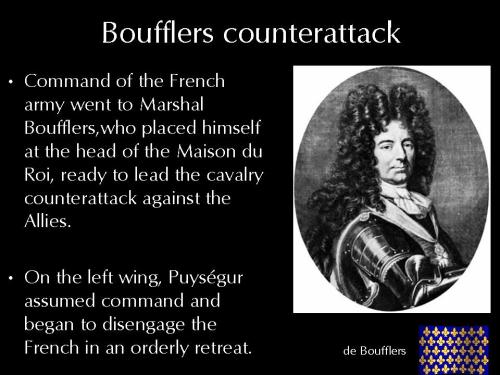
On the left flank, the French gained a notable success, scattering Allied cavalry in the act of deployment.
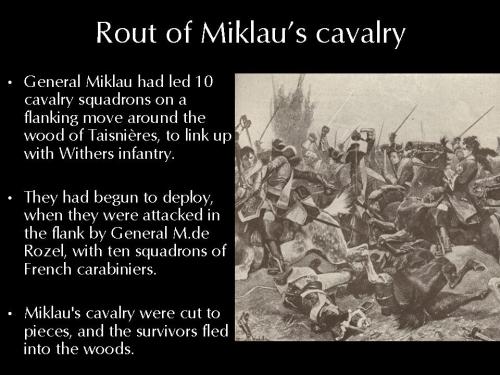
The cavalry battle in the centre ebbed to and fro, as the Allies tried to establish a bridgehead.

The Allies were driven back against the redans, only for the French to be dispersed by British infantry fire.
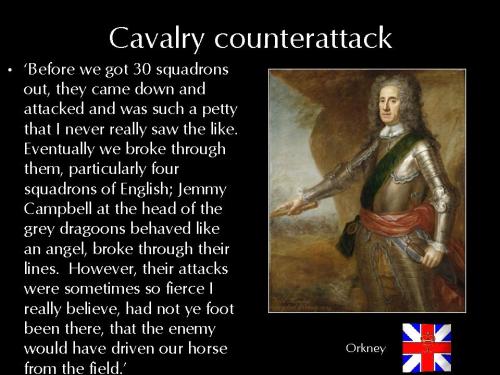
Boufflers led six charges to countain the Allied advance, led by Marlborough and Eugene in person, but were slowly pressed back by weight of numbers. The French retired onto the plain behind the redans, where the cavalry struggle continued.
Meanwhile, the Dutch eventually forced the French from their prepared positions on their right flank.
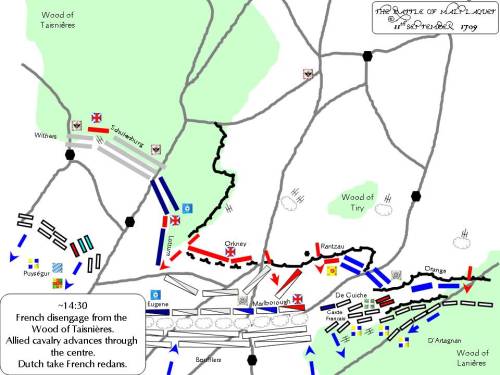
The battle now ended. The French now left the field in good order, both wings retiring, covered by the cavalry in the centre. The Allies were too exhausted to pursue.
By the terms of 18thC warfare, the Allies had won the battle, since they possessed the field, but had lost considerably more men in combat. In this sense, the battle was a technical victory for the Allies, rather than the earlier crushing defeats that Marlborough inflicted on the French.

Reflections on the aftermath of the battle make sombre reading…
‘The day was very bloody, and disputed for more than six hours with more obstinacy and uncertainty of result than I know how to describe. The Princes and generals who saw yesterday the left of the battlefield were horror-struck to see our men stretched before the entrenchment and within it in their ranks as they had fought.’
van Goslinga
‘In many places they lye as thick as you ever saw a flock of sheep, and where our cousin Tuillibardine was, it was prodigious. I think I never saw the like.’
‘He only wonders how anyone comes off where bullets fly so thick… None alive ever saw such a battle, God give us a good peace… I hope to God it may be the last battle I may see.’
Orkney
‘I am so tired that I have but strength enough to tell you that we have had this day a very bloody battle, the first part of the day we beat their foot, and afterwards their horse. God Almighty be praised, it is now in our powers to have what peace we please, and I may be pretty well assured of never being in another battle.’
Marlborough to Sarah, his Wife, Personal letter on the night of the battle.
‘It is melancholy to see so many brave men killed, with whom I have lived these last eight years, when we thought ourselves sure of a peace.’
Marlborough to Godolphin, October 3rd 1709
Despite his crippling wound Marshal Villars recovered, and wrote to Louis XIV, describing the pyrrhic victory he believed the Allies had won.

For certain, he had prevented an invasion of France in 1709, and kept her hopes alive for better terms in any future peace treaty.
Widespread shock at the level of casualties from the battle was felt across European society.
‘Ye joy here doe not appear proportional to the success; for ye cries of widows, orphans and tender virgins, deprived of their husbands, fathers and Gallants prevail so much amongst this phlegmatic nation that I believe the beaten French will carry off disgrace with better countenance than ye Dutch triumphant express their Glory; but to say the truth the Dutch troops suffered extremely… Walpole, the Hague, 17th September 1709
Malplaquet was the last major battle that the Duke of Malborough fought during the war of the Spanish Succession, although he continued in the field for another two years, gaining further victories and territory from the French.
The battlefield is commemorated today by monuments, both in France
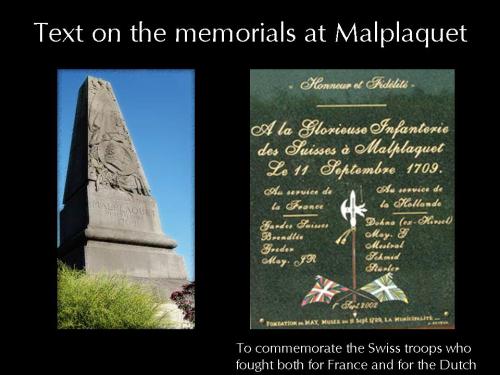
and on the column of victory at Blenheim Palace, England.
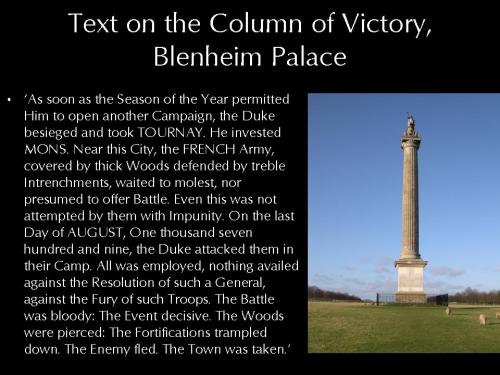
The battle also lives on in France in a folk song, Malbrough s’en va-t-en guerre. This suggests that The Duke of Marlborough died during the day’s action, and the news is eventually passed to his wife, Sarah Churchill, Mistress of the Robes to Queen Anne. It became popular in France as a children’s song, and still survives, a faint echo of that bloody day in 1709.
The full slide pack is available as a pdf file here, (7 Mb file!), or as a powerpoint slideshow (pps) Malplaquet 1709 (12 Mb file!) .
